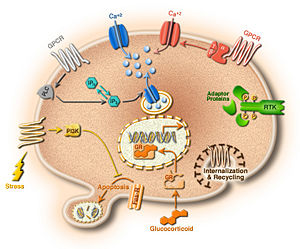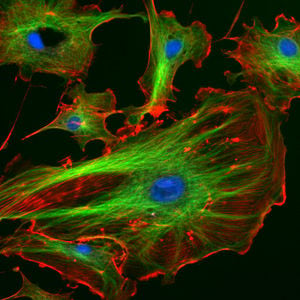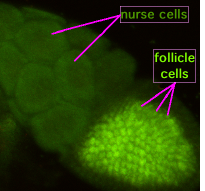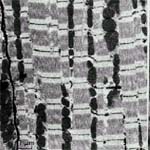Difference between revisions of "Cellular biology" - New World Encyclopedia
Rick Swarts (talk | contribs) |
Rick Swarts (talk | contribs) |
||
| Line 4: | Line 4: | ||
The ojbect of cell biology, a '''cell''' is the structural and functional unit of all living organisms and is sometimes called the "building block of [[life]]" (Alberts 2002). Some organisms, such as [[bacteria]], are unicellular, consisting of a single cell. Other organisms, such as [[human]]s, are multicellular. | The ojbect of cell biology, a '''cell''' is the structural and functional unit of all living organisms and is sometimes called the "building block of [[life]]" (Alberts 2002). Some organisms, such as [[bacteria]], are unicellular, consisting of a single cell. Other organisms, such as [[human]]s, are multicellular. | ||
| + | |||
| + | Knowing the composition of cells and how cells work is fundamental to all of the [[biology|biological sciences]]. Appreciating the similarities and differences between cell types is particularly important to the fields of cell and molecular biology. These fundamental similarities and differences provide a unifying theme, allowing the principles learned from studying one cell type to be extrapolated and generalized to other cell types. | ||
Cell biology is done both on a [[microscope|microscopic]] and [[molecule|molecular]] level, and extends to both single-celled organisms and the many specialized cells in multicellular [[organisms]]. | Cell biology is done both on a [[microscope|microscopic]] and [[molecule|molecular]] level, and extends to both single-celled organisms and the many specialized cells in multicellular [[organisms]]. | ||
| − | |||
| − | |||
Research in cell biology is closely related to [[genetics]], [[biochemistry]], [[molecular biology]], and [[developmental biology]]. | Research in cell biology is closely related to [[genetics]], [[biochemistry]], [[molecular biology]], and [[developmental biology]]. | ||
| Line 27: | Line 27: | ||
Chromosome behavior in animal ([[salamander]]) cells was later described in detail by [[Germany|German]] [[anatomy|anatomist]] Walther Flemming, the discoverer of [[mitosis]], in 1882. | Chromosome behavior in animal ([[salamander]]) cells was later described in detail by [[Germany|German]] [[anatomy|anatomist]] Walther Flemming, the discoverer of [[mitosis]], in 1882. | ||
| − | + | Over time, a comprehensive cell theory was developed that included these doctrines: all organisms are composed of one or more cells; all cells come from preexisting cells; all vital functions of an organism occur within cells, and cells contain the [[genetics|hereditary information]] necessary for regulating cell functions and for transmitting information to the next generation of cells. | |
| + | |||
| + | In 1953, on February 28, Watson and Crick made their first announcement on the double-helix structure for [[DNA]]. | ||
In 1981, [[Lynn Margulis]] published ''Symbiosis in Cell Evolution'' detailing the [[endosymbiotic theory]] that some cell organelles (mitochondria and chloroplasts) trace their origins to [[prokaryote]] organisms. | In 1981, [[Lynn Margulis]] published ''Symbiosis in Cell Evolution'' detailing the [[endosymbiotic theory]] that some cell organelles (mitochondria and chloroplasts) trace their origins to [[prokaryote]] organisms. | ||
| Line 33: | Line 35: | ||
==Processes== | ==Processes== | ||
Cell biology studies numerous processes, including the following: | Cell biology studies numerous processes, including the following: | ||
| − | *[[Cell division]] - The origin of new cells. | + | *[[Cell division]] ([[binary fission]] and [[mitosis]]) - The origin of new cells. |
*[[Cell signaling]] - Regulation of cell behavior by signals from outside. | *[[Cell signaling]] - Regulation of cell behavior by signals from outside. | ||
*[[Active transport]] and [[Passive transport]] - Movement of molecules into and out of cells. | *[[Active transport]] and [[Passive transport]] - Movement of molecules into and out of cells. | ||
| Line 58: | Line 60: | ||
==Techniques== | ==Techniques== | ||
[[Image:Drosophila m oogenesis.png|thumb|right|300px]] | [[Image:Drosophila m oogenesis.png|thumb|right|300px]] | ||
| − | *[[Microscopy]] and [[Immunostaining]] | + | Some techniques used in cell biology include the following: |
| − | *[[Gene knockdown]] and [[Transfection]] | + | *[[Microscope|Microscopy]] and [[Immunostaining]] |
| + | *[[Gene knockdown]]* and [[Transfection]]* | ||
*[[Cell culture]] and [[Radioactive tracer]]s | *[[Cell culture]] and [[Radioactive tracer]]s | ||
| − | *[[ | + | *[[Polymerase chain reaction]] and [[In situ hybridization]]* |
| − | *[[DNA | + | *[[DNA]] microarray screens of gene expression |
===Purification of cells and their parts=== | ===Purification of cells and their parts=== | ||
Purification of cells and their parts is achieved in the following ways: | Purification of cells and their parts is achieved in the following ways: | ||
| − | *[[Flow cytometry]] | + | *[[Flow cytometry]]* |
| − | *[[Cell fractionation]] | + | *[[Cell fractionation]]* |
**Release of cellular organelles by disruption of cells. | **Release of cellular organelles by disruption of cells. | ||
**Separation of different organelles by [[centrifugation]]. | **Separation of different organelles by [[centrifugation]]. | ||
| Line 78: | Line 81: | ||
*[[Cilia]] - motile [[microtubule]]-containing structures of [[eukaryote]]s | *[[Cilia]] - motile [[microtubule]]-containing structures of [[eukaryote]]s | ||
*[[Cytoplasm]] - contents of the main fluid-filled space inside cells | *[[Cytoplasm]] - contents of the main fluid-filled space inside cells | ||
| − | *[[Cytoskeleton]] - protein filaments inside cells | + | *[[Cytoskeleton]]* - protein filaments inside cells |
*[[Ribosome]] - [[RNA]] and protein complex required for protein synthesis in cells | *[[Ribosome]] - [[RNA]] and protein complex required for protein synthesis in cells | ||
*[[Endoplasmic reticulum]] - major site of membrane [[protein synthesis]] | *[[Endoplasmic reticulum]] - major site of membrane [[protein synthesis]] | ||
| Line 84: | Line 87: | ||
*[[Golgi apparatus]] - site of protein [[glycosylation]] in the [[endomembrane]] system | *[[Golgi apparatus]] - site of protein [[glycosylation]] in the [[endomembrane]] system | ||
*[[cell membrane|Membrane]] [[lipid]] and [[protein]] barrier | *[[cell membrane|Membrane]] [[lipid]] and [[protein]] barrier | ||
| − | *[[Lipid | + | *[[Lipid]] bilayer - fundamental organizational structure of [[cell membrane]]s |
| − | *[[vesicle (biology)|Vesicle]] - small membrane-bounded spheres inside cells | + | *[[vesicle (biology)|Vesicle]]* - small membrane-bounded spheres inside cells |
*[[Mitochondrion]] - major energy-producing organelle | *[[Mitochondrion]] - major energy-producing organelle | ||
*[[Cell nucleus|Nucleus]] - holds most of the [[DNA]] of eukaryotic cells | *[[Cell nucleus|Nucleus]] - holds most of the [[DNA]] of eukaryotic cells | ||
| − | |||
| Line 94: | Line 96: | ||
*{{NCBI-scienceprimer}} | *{{NCBI-scienceprimer}} | ||
* Alberts, B., D. Bray, J. Lewis, M. Raff, K. Roberts, and J. D. Watson. 1989. ''Molecular Biology of the Cell'', second edition. New York: Garland Publishing. ISBN 0824036956 | * Alberts, B., D. Bray, J. Lewis, M. Raff, K. Roberts, and J. D. Watson. 1989. ''Molecular Biology of the Cell'', second edition. New York: Garland Publishing. ISBN 0824036956 | ||
| + | * Hooke, R. 1665 (1667 printing). [http://digital.library.wisc.edu/1711.dl/HistSciTech.HookeMicro ''Micrographia: Or Some Physiological Descriptions of Minute Bodies Made by Magnifying Glasses With Observations and Inquiries Thereupon...'']. Retrieved February 2, 2007. | ||
==External links== | ==External links== | ||
Revision as of 04:17, 3 February 2007
Cell biology or cellular biology (formerly cytology, from the Greek kytos, "container") is an academic discipline that studies cells, including their physiological properties, structure, organelles, environmental interactions, life cycle, division, and death.
The ojbect of cell biology, a cell is the structural and functional unit of all living organisms and is sometimes called the "building block of life" (Alberts 2002). Some organisms, such as bacteria, are unicellular, consisting of a single cell. Other organisms, such as humans, are multicellular.
Knowing the composition of cells and how cells work is fundamental to all of the biological sciences. Appreciating the similarities and differences between cell types is particularly important to the fields of cell and molecular biology. These fundamental similarities and differences provide a unifying theme, allowing the principles learned from studying one cell type to be extrapolated and generalized to other cell types.
Cell biology is done both on a microscopic and molecular level, and extends to both single-celled organisms and the many specialized cells in multicellular organisms.
Research in cell biology is closely related to genetics, biochemistry, molecular biology, and developmental biology.
Origins and development of cell biology
Cells were discovered in the middle of the seventeenth century. Robert Hooke, an Englishman, discovered cells in cork using an early microscope, and in 1665 he published a book entitled Micrographia with his observations. Hooke coined the biological term cell because his observations of plant cells reminded him of monks' cells which were called "cellula". He is often credited with the discovery of the cell, and although his microscope was very basic, research by British scientist Brian J. Ford has now shown that Hooke could have observed cork cells with it.
Over time, biologists discovered cells in a wide variety of plants and animals, as well as microorganisms, and identified key parts, such as the cell nucleus.
The cell doctrine arose in the 1830s and held that plants and animals are made up of cells and that cells are the common unit of structure. This major tenet of cell biology was first developed in 1839 by Matthias Jakob Schleiden and Theodor Schwann.
Later in the century, Rudolph Virchow stated that cells always emerge from cell divisions (omnis cellula ex cellula) establishing a second fundamental tenet of cell biology that cells arise from preexisting cells by cell division.
Chromosomes were first observed in plant cells by Swiss botanist Karl Wilhelm von Nägeli in 1842, and independently in Ascaris worms by Belgian scientist Edouard Van Beneden (1846-1910).
Chromosome behavior in animal (salamander) cells was later described in detail by German anatomist Walther Flemming, the discoverer of mitosis, in 1882.
Over time, a comprehensive cell theory was developed that included these doctrines: all organisms are composed of one or more cells; all cells come from preexisting cells; all vital functions of an organism occur within cells, and cells contain the hereditary information necessary for regulating cell functions and for transmitting information to the next generation of cells.
In 1953, on February 28, Watson and Crick made their first announcement on the double-helix structure for DNA.
In 1981, Lynn Margulis published Symbiosis in Cell Evolution detailing the endosymbiotic theory that some cell organelles (mitochondria and chloroplasts) trace their origins to prokaryote organisms.
Processes
Cell biology studies numerous processes, including the following:
- Cell division (binary fission and mitosis) - The origin of new cells.
- Cell signaling - Regulation of cell behavior by signals from outside.
- Active transport and Passive transport - Movement of molecules into and out of cells.
- Adhesion - Holding together cells and tissues.
- Transcription and mRNA splicing - gene expression.
- Cell movement: Chemotaxis, Muscle contraction, cilia, and flagella
- DNA repair and Cell death
- Metabolism: Glycolysis, Respiration, Photosynthesis
Another process studied is the movement of proteins.
Movement of proteins
Every cell typically contains hundreds of different kinds of macromolecules that function together to generate the behavior of the cell. Each type of protein is usually sent to a particular part of the cell. An important part of cell biology is investigation of molecular mechanisms by which proteins are moved to different places inside cells or secreted from cells.
Most proteins are synthesized by ribosomes in the cytoplasm. This process is also known as protein biosynthesis or simply protein translation.
Some proteins, such as those to be incorporated in membranes (membrane proteins), are transported into the endoplasmic reticulum (ER) during synthesis and further processed in the Golgi apparatus. From the Golgi, membrane proteins can move to the plasma membrane, to other subcellular compartments or they can be secreted from the cell. The ER and Golgi can be thought of as the "membrane protein synthesis compartment" and the "membrane protein processing compartment", respectively. There is a semi-constant flux of proteins through these compartments. ER and Golgi-resident proteins associate with other proteins, but remain in their respective compartments. Other proteins "flow" through the ER and Golgi to the plasma membrane. Motor proteins transport membrane protein-containing vesicles along cytoskeletal tracks to distant parts of cells such as axon terminals.
Some proteins that are made in the cytoplasm contain structural features that target them for transport into mitochondria or the nucleus. Some mitochondrial proteins are made inside mitochondria and are coded for by mitochondrial DNA. In plants, chloroplasts also make some cell proteins.
Extracellular and cell surface proteins destined to be degraded can move back into intracellular compartments upon being incorporated into endocytosed vesicles. Some of these vesicles fuse with lysosomes where the proteins are broken down to their individual amino acids. The degradation of some membrane proteins begins while still at the cell surface when they are cleaved by secretases. Proteins that function in the cytoplasm are often degraded by proteasomes.
Techniques
Some techniques used in cell biology include the following:
- Microscopy and Immunostaining
- Gene knockdown and Transfection
- Cell culture and Radioactive tracers
- Polymerase chain reaction and In situ hybridization
- DNA microarray screens of gene expression
Purification of cells and their parts
Purification of cells and their parts is achieved in the following ways:
- Flow cytometry
- Cell fractionation
- Release of cellular organelles by disruption of cells.
- Separation of different organelles by centrifugation.
- Proteins extracted from cell membranes by detergents and salts or other kinds of chemicals.
- Immunoprecipitation
Some structures inside cells
- Organelle - term used for major subcellular structures
- Chloroplast - key organelle for photosynthesis
- Cilia - motile microtubule-containing structures of eukaryotes
- Cytoplasm - contents of the main fluid-filled space inside cells
- Cytoskeleton - protein filaments inside cells
- Ribosome - RNA and protein complex required for protein synthesis in cells
- Endoplasmic reticulum - major site of membrane protein synthesis
- Flagella - motile structures of bacteria, archaea and eukaryotes
- Golgi apparatus - site of protein glycosylation in the endomembrane system
- Membrane lipid and protein barrier
- Lipid bilayer - fundamental organizational structure of cell membranes
- Vesicle - small membrane-bounded spheres inside cells
- Mitochondrion - major energy-producing organelle
- Nucleus - holds most of the DNA of eukaryotic cells
ReferencesISBN links support NWE through referral fees
- This article contains material from the Science Primer published by the NCBI, which, as a US government publication, is in the public domain at http://www.ncbi.nlm.nih.gov/About/disclaimer.html.
- Alberts, B., D. Bray, J. Lewis, M. Raff, K. Roberts, and J. D. Watson. 1989. Molecular Biology of the Cell, second edition. New York: Garland Publishing. ISBN 0824036956
- Hooke, R. 1665 (1667 printing). Micrographia: Or Some Physiological Descriptions of Minute Bodies Made by Magnifying Glasses With Observations and Inquiries Thereupon.... Retrieved February 2, 2007.
External links
- American Society for Cell Biology
- BMC Cell Biology - online journal, open access
- Journal of Cell Biology - older issues free
- Journal of Cell Science - older issues free
| General subfields within Biology |
|---|
| Anatomy | Biochemistry | | Botany | Cell biology | Ecology | Developmental biology | Ethnobotany | Evolutionary biology | Genetics | Ichthyology | Limnology | Medicine | Marine biology | Human biology | Microbiology | Molecular biology | Origin of life | Paleobotany | Paleoclimatology | Paleontology | Parasitology | Pathology | Physiology | Taxonomy | Zoology |
Credits
New World Encyclopedia writers and editors rewrote and completed the Wikipedia article in accordance with New World Encyclopedia standards. This article abides by terms of the Creative Commons CC-by-sa 3.0 License (CC-by-sa), which may be used and disseminated with proper attribution. Credit is due under the terms of this license that can reference both the New World Encyclopedia contributors and the selfless volunteer contributors of the Wikimedia Foundation. To cite this article click here for a list of acceptable citing formats.The history of earlier contributions by wikipedians is accessible to researchers here:
The history of this article since it was imported to New World Encyclopedia:
Note: Some restrictions may apply to use of individual images which are separately licensed.



